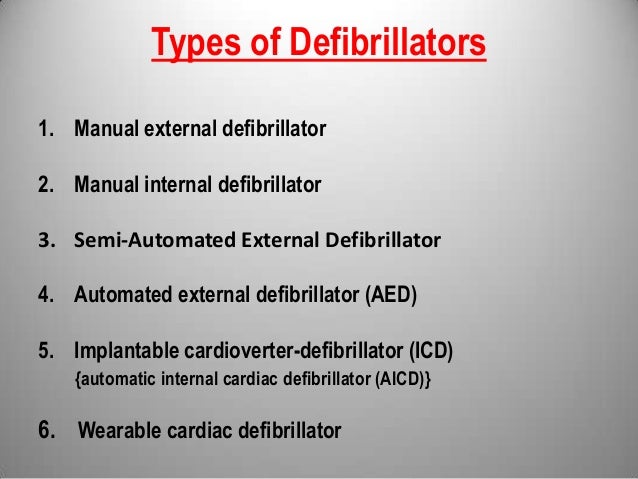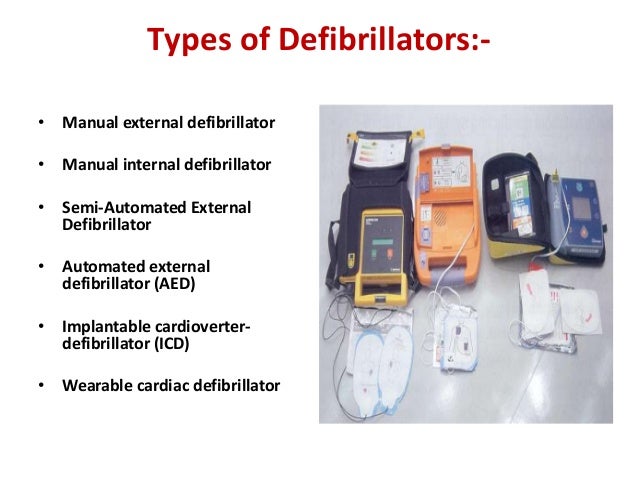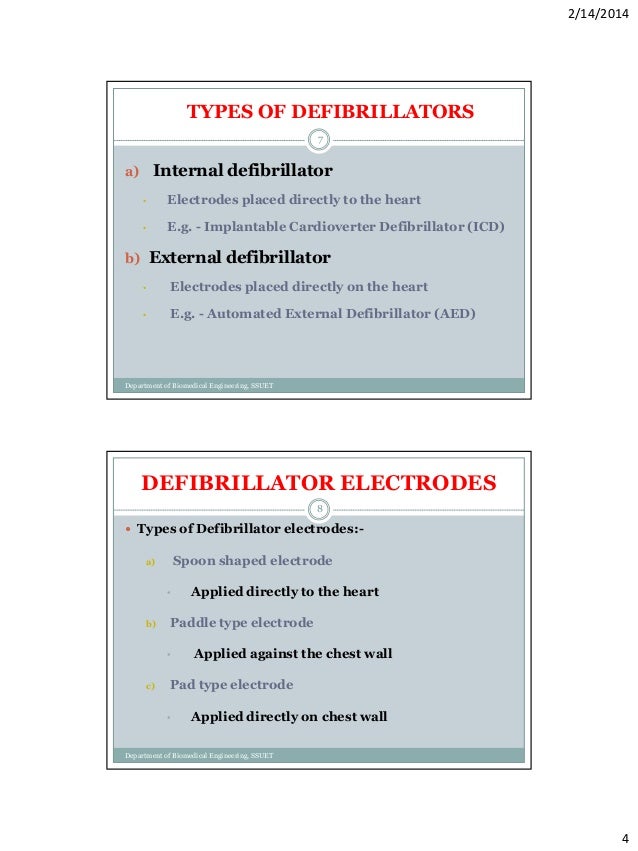Defibrillation#Types
A defibrillator, and shock sensors, is a medical device for defibrillation and cardioversion. It can finish targeted by power surges cardiac arrhythmias such as ventricular fibrillation and ventricular flutter (defibrillation ) or ventricular tachycardia, atrial fibrillation and atrial flutter ( cardioversion ). Defibrillators are in intensive care units, operating rooms, emergency rooms in, and kept in vehicles of the emergency services, increasingly since the 1990s also in public buildings such as railway stations, airports and other places for use by non-medical professionals.
- 3.1 Manual defibrillator
- 3.2 Automated external defibrillator ( AED)
- 3.3 An implantable cardioverter-defibrillator
- 3.4 defibrillator vest (WCD - Wearable cardioverter / defibrillator )
Indication and therapy
Defibrillation
In 85 percent of sudden cardiac death is initially before a so-called ventricular fibrillation. A defibrillator can interrupt this electrically circulating excitation in the heart by simultaneous stimulation of at least 70 percent of all heart muscle cells. In this case, a large number of cells are depolarised at the same time, with the result that these cells are no longer a relatively long time ( 250 ms = refractory period of the cells) excitable. The circular wave is virtually cut off the path and the heart is again in a state in which the natural conduction system can take over the pacing of the heart again. Crucial in defibrillation is the earliest possible use as caused by ventricular fibrillation under-supply the brain with oxygen ( cerebral ischemia ) within a short time can lead to massive neurological deficits. For this reason, also be placed in the public space more and more automated external defibrillators ( AED). The successful use of an AED stands and falls with the correct implementation of cardiopulmonary resuscitation. The AED is only a complement to, not a replacement. However, it should be added that in a ventricular fibrillation per minute, the chance of survival of the patient is reduced by 10%. It is therefore necessary and the use of a defibrillator laity should take place as early as possible.
Cardioversion
Cardioversion is an ECG - synchronous defibrillation short anesthesia. Here, the current pulse ( usually with a lower energy 100 Joules ) is released directly after detection of a chamber complex (large wave in the EKG) through the device. It is used in patients with atrial fibrillation for the recovery of sinus rhythm and can not be controlled with medication, rapid malignant cardiac arrhythmias of the heart chambers (eg ventricular tachycardia).
Construction
Basically, a defibrillator, a battery, a DC / DC converter, a capacitor, an output circuit and a control unit. Since the voltage of the battery is too small for an electric shock, a larger voltage to be generated by means of a DC / DC converter, with which the capacitor is charged to a preset energy. By pressing a button, the capacitor releases its stored energy, about 200 to 360 joules, to the patient. The voltage is up to 4000 volts and is between 3 and 40 milliseconds. The current intensity obtained at normal body resistances between 50 ohms and 100 ohms to about 50 amps. The necessary for this capacitor has a capacitance of 45μF to 500μF.
This energy is delivered via large electrodes, which are either pressed on the patient's chest with your hands ( the so-called " paddles " ) or are stuck to the chest ( " adhesive electrodes " or " Fast-Patch "). Especially with defibrillators publicly accessible ( " PAD " public access defibrillator ) be - in order to simplify the operation and reduce the risk of electric shock to the user - practically only used adhesive electrodes.
For use with open chest ( during surgery ), there are versions with spoon-shaped electrodes which are applied directly to the heart muscle.
The output circuit provides for the generation of certain pulse shapes. The controller regulates the charging process of the capacitor, directs the output circuit and also makes sure that is discharged in a failure to deliver a shock to the capacitor through an internal resistor ( protection circuit ).
Modern defibrillators work biphasic. This means that from the output stage not only delivering an electrical shock, but that are submitted by voltage change on the paddles and power surges in the reverse direction. Biphasic devices thus allow to manage at the same effectiveness with lower energy output and reduced damage to the heart muscle. Modern biphasic defibrillators measure before the energy output of the body resistance (impedance ) of the patient by means of glued electrodes and adjust amperage and voltage to this resistance. Slender, small patients with low impedance so get less power than, say, overweight, large patients. There is now also an evidence that escalating energy levels are more effective than the same high energy charges to the patient.
Types
Manual defibrillator
Conventional (manual ) defibrillators also contain functions of an ECG and are used for example in the emergency service. Some of these devices can also be used as an external pacemaker as well as for measuring the oxygen saturation, blood pressure measurement or as Capnometer and have often incorporated an option for semi-automatic defibrillation for use by the non- medical rescue service personnel.
Automated external defibrillator ( AED)
Automated external defibrillators (AED ugs, " public access defibrillators " ) are suitable due to their construction and operation especially for lay persons.
An implantable cardioverter-defibrillator
In patients at high risk for ventricular fibrillation or other malignant arrhythmia miniaturized automatic defibrillators ( implantable cardioverter defibrillators, or ICD of English Internal cardioverter / defibrillator ), similar to a cardiac pacemaker, implanted. Your electrodes ( main electrode is located in the apex of the right ventricle ) have direct contact with the heart muscle and loosen as needed from their own. Through direct contact much lower energies are possible, but the patient noted quite a painful blow. This can be mentally stressful despite the life-saving function for the patient.
Vest defibrillator (WCD - Wearable cardioverter / defibrillator )
Should patients be protected against a temporary existing, increased risk of life-threatening rapid heart rhythm disturbances, for example, before implantation of an ICD or CRT -D, so they can be protected by a defibrillator vest ( wearable cardioverter / defibrillator, WCD). This is also in existing Tachyarrhythmierisiko with unknown history, or during extended periods of risk for bridging a phase in which the patient is inoperable applicable.
WCD is a therapeutic device, which consists of two components substantially. The worn directly on the skin of the upper body electrode belt contains four ECG electrodes and three therapy electrodes. The cable transmits two ECG leads for cardiac rhythm monitoring to a monitor, the actual defibrillator.
Upon detection of a malignant fast arrhythmia, the device automatically starts the treatment mode. This is optical, acoustic and signaled directly to the patient and the environment through a vibration alarm. Reacts the patient is not due to loss of consciousness, the necessary treatment procedure is automatically performed by the defibrillator vest.
In this case, the unconscious patient is on the person sitting in the back and below the left breast therapy electrode life-saving shock. This is because existing unconsciousness for the patient not noticeable and therefore painless.
If the patient during therapy alarm still conscious, he suppressed by means of two response keys a shock. Case of a later loss of consciousness, he can no longer press the response keys and the device then continues the treatment mode to saving electric shock.
Stops the fast rhythm disorder by itself, the WCD the treatment procedure terminates after a recognized normal ECG signal automatically.
All critical rhythm events are stored in the monitor, and are by the attending physician on an Internet database available.
Documentation
Different types of modern defibrillators draw on the derived ECG events, given shocks with their energy, the corresponding times and under certain circumstances, the ambient noise and the conversations of the helper internally or on memory cards. The analysis of this data can also computerized, are taking over in the medical record, quality assurance, research or forensic purposes.
History
Once the principle had been recognized already in the 1930s in experiments at Johns Hopkins University from electrical engineer William B. Kouwenhoven, in collaboration with physicians and has been used in operations in 1947 by the first surgeon Claude Beck ( Case Western Reserve University ), the development of yet defibrillator for use in closed- chest in 1950 at Johns Hopkins University by a Kouwenhoven, again in close collaboration with physicians. The device has been successfully used in an operation 1957 and 1960 for the first time in a patient in the receptacle. 1965 invented the British- Irish cardiologist Frank Pantridge the first portable defibrillator.










